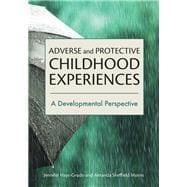
Adverse and Protective Childhood Experiences
by Hays-grudo, Jennifer; Morris, Amanda SheffieldBuy New
Rent Textbook
Rent Digital
Downloadable: 180 Days
Downloadable: 365 Days
Downloadable: Lifetime Access
Used Textbook
We're Sorry
Sold Out
This item is being sold by an Individual Seller and will not ship from the Online Bookstore's warehouse. The Seller must confirm the order within two business days. If the Seller refuses to sell or fails to confirm within this time frame, then the order is cancelled.
Please be sure to read the Description offered by the Seller.
Summary
Author Biography
Amanda Sheffield Morris, PhD, is a Regents Professor of Human Development and Family Science, Oklahoma State University. She received her PhD from Temple University in Psychology, was a post-doctoral fellow at Arizona State University, and taught at the University of New Orleans for five years. Her research focuses on the role of emotion regulation in child and adolescent adjustment and the ways in which children learn successful regulation skills.
Table of Contents
Acknowledgements
I. The Effects of Adverse and Protective Childhood Experiences
1. Adverse Childhood Experiences
The Adverse Childhood Experiences Study
ACEs Studies in Other Populations
ACEs in Children and Adolescents
Defining ACEs
Knowing One’s ACE Score
2: Protective and Compensatory Experiences: The Antidote to ACEs
PACEs: Relationships and Resources
PACEs Foundational Theories and Research
Our Research on PACEs
Knowing One’s PACE Score
Part II. How Early Experience Influences the Body, Brain, and Behavior
3. Effects of Early Life Adversity on Neurobiological Development
Models of Biobehavioral Responses to Childhood Adversity
Epigenetics and Childhood Adversity
Effects of Childhood Adversity on Brain Structure and Function
Putting It All Together: The ICARE Model
4. The Intergenerational Transmission of ACEs and PACEs
Psychosocial Transmission of Adversity and Resilience
Neurobiological Transmission of Parenting
Neurobiological Transmission of Adversity and Resilience
Conclusions and Activity: ACEs and PACEs Genograms
III. Breaking the Cycle of ACEs and Increasing PACEs
5. Repairing the Effects of ACEs in Adulthood
ACE-Based Science as a Foundation for Interventions
PACEs for Adults
Conclusions and Activity: Creating an Adult PACEs Plan
6. Promoting Positive Development in Children with ACEs
PACEs for Children
PACEs for Adolescents
Enhancing Neurobiological Regulation
Fostering Positive Caregiver–Child Relationships
Systems-Level Programs
Conclusions and Activity: Creating a Child PACEs Plan
7. ACEs and PACEs and Communities
The Historical and Social Context of ACEs
Trauma-Informed Practices
Community Coalitions Focused on ACEs and Resilience
Policy Change and Legislation
Adverse Community Environments and Adverse Childhood Experiences: A Pair of ACEs
8: Putting It All Together: Summary and Solutions
What We Have Learned
Solutions—What to Do Next
Finding A Life Raft
Appendix: Questions for Reflection
Resources
References
Index
About the Authors
An electronic version of this book is available through VitalSource.
This book is viewable on PC, Mac, iPhone, iPad, iPod Touch, and most smartphones.
By purchasing, you will be able to view this book online, as well as download it, for the chosen number of days.
A downloadable version of this book is available through the eCampus Reader or compatible Adobe readers.
Applications are available on iOS, Android, PC, Mac, and Windows Mobile platforms.
Please view the compatibility matrix prior to purchase.
